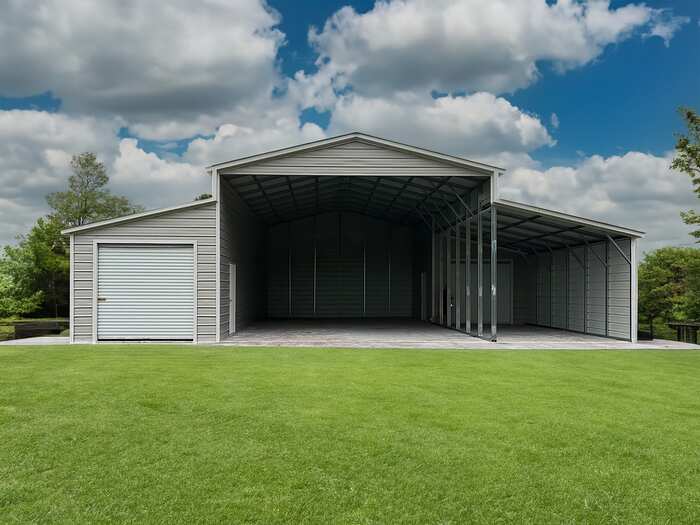A metal garage can be more than a place to park vehicles. It often becomes extra storage, a workshop, or a workspace for projects that need room and structure. Choosing one involves several moving parts, from the type of framing to the local regulations. A clear understanding of these elements helps buyers avoid delays, added costs, and structural issues later on.
Structural Choices and Material Strength
When comparing metal garages, the framework and sheeting deserve the first look. Many structures use steel tube framing, which provides strong support against bending and pressure. The strength depends on gauge framing, with lower numbers indicating thicker steel. Thicker framing handles heavier loads and resists corrosion better, which matters in areas exposed to moisture or wind.
Panels also vary. Some use metal roof panels designed for water runoff, while others rely on corrugated or flat metal sheeting. The style and overlap of panels affect both appearance and protection. Attention to these small details determines how a garage performs through weather conditions year after year.
Foundation, Anchoring, and Stability
A stable base is essential for any metal structure. Most garages sit on a concrete foundation or concrete slab, depending on site conditions and intended use. A thicker slab may suit heavy machinery or multiple vehicles, while lighter setups can work with compacted gravel.
Once the base is ready, anchor bolts secure the frame to the surface. Proper anchoring prevents movement from wind or shifting soil. Every installer uses slightly different spacing and hardware, so checking alignment and depth early in the construction process saves rework later.
Planning, Design, and Building Requirements
Before anything is ordered, a material list and clear garage plans should be completed. Plans define door placement, wall height, and load capacity. When handled correctly, they also simplify the building inspection phase.
Most areas have building codes that dictate snow load, wind resistance, and setbacks. Submitting engineering drawings that match local regulations avoids delays. Inspectors often look for details such as footing size and connection strength. Getting these right early prevents the frustration of corrections after construction begins.
Function and Layout
Every garage serves a different purpose. Some buyers focus on vehicle storage, others design metal workshops or hobby spaces. It helps to think about the flow of movement, door placement, and the type of garage doors that fit the plan. Roll-up styles save space, while sectional doors suit garages attached to homes.
Lighting and outlets also affect usability. Installing conduit and fixtures during the early stages of the project costs less than retrofitting later. If the structure will double as a metal barn or a commercial building, consider larger openings and better ventilation to keep it functional through changing seasons.
Durability and Maintenance
Metal structures have earned a reputation for long life, but they still face wear and tear. Galvanized coatings and high-quality materials help extend service life. Keeping the roof clear of debris and checking seams each season prevents moisture from pooling or seeping.
Color finishes also contribute to longevity. Modern color options often use baked-on paint systems that resist fading and peeling. A lighter shade can reflect sunlight and help with energy efficiency, especially in warmer climates.
Prefabrication and Installation
Many suppliers provide prefab steel structures that arrive ready to assemble. A prefabricated building reduces onsite labor and limits exposure to weather during construction. Most companies include delivery and installation, though site preparation is the owner’s responsibility.
Reviewing the timeline and sequence helps keep everyone aligned. Crews typically set framing first, attach panels, and seal joints before doors and trims go in. If the garage includes interior finishing, electrical or insulation work should follow framing but before panel closure. Careful scheduling keeps the project efficient and avoids double-handling.
Roof Design and Drainage
The roof defines both appearance and performance. The vertical roof style stands out for its practicality. Vertical panels allow rain and snow to slide off easily, reducing load and extending roof life. Combined with a ridge cap and proper gutters, it keeps water from accumulating near the structure’s base.
Other designs use horizontal or boxed-eave styles, which may look closer to residential architecture. Regardless of the option, the roof pitch should always align with local climate and drainage needs. Small differences in slope can affect how long the roof stays dry after a storm.
Efficiency, Upkeep, and Long-Term Value
Beyond structural choices, steps that make your garage environmentally friendly also improve long-term comfort. Insulation, sealed joints, and reflective coatings can lower heat gain or loss, improving energy efficiency. Regular cleaning of exterior panels and rechecking fasteners after heavy storms helps keep the structure solid.
If the garage shares property with a metal carport, coordinate finishes and rooflines for a consistent appearance and runoff management. Keeping guttering and trim aligned avoids trapped water and staining.
Even in areas with supply constraints, maintaining communication within the supply chain keeps parts and accessories available when needed. Small delays early can ripple across the project, so confirming delivery schedules helps avoid gaps in progress.
Conclusion
Buying a metal garage involves more than comparing prices or picking colors. Every step affects safety and durability. Careful planning, accurate drawings, and quality construction practices lead to a space that lasts. Whether it ends up as a metal building for storage or a practical workspace, thoughtful preparation turns a simple structure into a dependable part of daily life.


